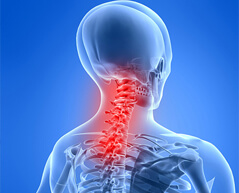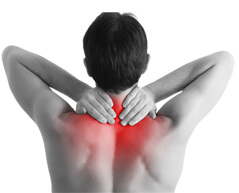Cervicl Pain
Cervical pain or Cervical spondylosis is usually an age-related condition that affects the joints in your neck. It develops as a result of the wear and tear of the cartilage and bones are of the cervical spine. While it is largely due to age, it can be caused by other factors as well. Alternative names for it include cervical osteoarthritis and neck arthritis.
The condition is present in more than 90 percent of people over the age of 65, although some have it in such small degrees that they never experience symptoms.
 For some, it can cause chronic pain, although many people who have it are still able to conduct normal, daily activities.
One of the causes for Cervical Spondylosis is aging. Cervical spondylosis often develops as a result of changes in your neck joints as you age. Your spinal disks can become dry and begin shrinking around the time you turn 40, reducing the cushioning between the bones in your neck.
The disk might also develop cracks as you get older. This causes them to bulge or become herniated. You might also develop bone spurs, or extra bony growths. Herniated disks and bone spurs can put extra pressure on your spinal cord and nerve roots, causing joint pain.
The ligaments in the patient's spine, which are strands of tissue that connect your bones, might also become stiffer as you age. This makes it more difficult or painful for you to move your neck.
For some, it can cause chronic pain, although many people who have it are still able to conduct normal, daily activities.
One of the causes for Cervical Spondylosis is aging. Cervical spondylosis often develops as a result of changes in your neck joints as you age. Your spinal disks can become dry and begin shrinking around the time you turn 40, reducing the cushioning between the bones in your neck.
The disk might also develop cracks as you get older. This causes them to bulge or become herniated. You might also develop bone spurs, or extra bony growths. Herniated disks and bone spurs can put extra pressure on your spinal cord and nerve roots, causing joint pain.
The ligaments in the patient's spine, which are strands of tissue that connect your bones, might also become stiffer as you age. This makes it more difficult or painful for you to move your neck.
cervical spondylosis can develop due to factors other than aging. These include neck injuries, work-related activities that put extra strain on your neck from heavy lifting, holding your neck in an uncomfortable position for prolonged periods of time, or repeating the same neck movements throughout the day (repetitive stress), genetic factors (family history of cervical spondylosis), smoking, being overweight and inactive. If the patient's like most people, he probably lives a busy, hectic life. But if you're living with cervical disc disease and have increased neck pain from injury or muscle pain, it's important to temporarily ease back on intense activities. While you are resting, find a comfortable position-one that causes you the least amount of neck pain. You can place a rolled up towel or a pillow under your neck to help keep your neck in a neutral position. Resting doesn't mean crawling into bed and remaining perfectly still, however. Staying immobile for more than a day or two actually can be harmful because it can decondition the muscles that support your neck and actually increase neck pain in the long run. While your neck is healing, adjust your activity level to what you can comfortably handle. As you improve, gradually increase your activity level back to normal. Most people with cervical spondylosis don't have noticeable symptoms. If symptoms do occur, they can range from mild to severe and may develop gradually or occur suddenly.

Planning your medical trip to India is a very simple process with Spine and Neuro Surgery Hospital India
- You just need to fill in our enquiry form and one of our executive will contact you soon.
- +91-9325887033 Call us at the given to contact number for any assistance.
- Complete information regarding surgery is provided on our website.
One common symptom is pain around the shoulder blade. Patients will complain of pain along the arm and in the fingers. The pain might increase on standing sitting, sneezing, coughing, or backward tilting of the neck.
Another common symptom is muscle weakness. Muscle weakness makes it hard to lift the arms or hold objects firmly. Other common signs include a stiff neck that becomes worse, headaches that mostly occur in the back of the head, tingling or numbness that mainly affects shoulders and arms, although it can also occur in the legs, Symptoms that occur less frequently often include a loss of balance and a loss of bladder or bowel control.
If you have the sudden onset o numbness or tingling in the shoulder, arms or legs or if you lose bowel or bladder control, talk to your doctor and seek medical attention as soon as possible.
The doctor will start by asking you several questions regarding your symptoms. Then, he or she will run through a set of tests. Typical exams include testing your reflexes, checking for muscle weakness, and testing the range of motion of your neck. Your doctor might also want to watch how you walk. All of this helps your doctor determine if your nerves and spinal cord are under too much pressure. If the doctor suspects cervical spondylosis, he or she will then order imaging tests and nerve function tests to confirm the diagnosis. X-rays can be used to check for bone spurs and other abnormalities.
A computerized tomography scan (CT scan) can provide more detailed images of your neck. Magnetic resonance imaging (MRI), which produces images using radio waves and a magnetic field, helps locate pinched nerves. A myelogram uses a dye injection to highlight certain areas of the spine; CT scans or X-rays are then used to provide more detailed images of these areas. An electromyogram (EMG) is used to check if your nerves are functioning normally when sending signals to your muscles; it measures your nerves' electrical activity.
A nerve conduction study is used to check the speed and strength of the signals your nerves send; this is done by placing electrodes on your skin where the nerve is located.
Treatments for cervical spondylosis focus on providing pain relief, lowering the risk of permanent damage, and helping you lead a normal life. Non-surgical methods are usually very effective.
The doctor might send you to a physical therapist for treatment. Physical therapy helps you stretch your neck and shoulder muscles and makes them stronger, which helps relieve pain. You might also have neck traction, which involves using weights to increase the space between the cervical joints and relieve the pressure on the cervical discs and nerve roots. The doctor might prescribe certain medications if over-the-counter drugs don't work. These include muscle relaxants, such as cyclobenzaprine, to treat muscle spasms, narcotics, such as hydrocodone, for pain relief, anti-seizure drugs, such as gabapentin, to relieve pain caused by nerve damage, steroid injections, such as prednisone, for pain relief.
 The tests for the cervical pain are available in many hospitals in India. Hospitals in cities like New Delhi and Nagpur specialise in treatment. These hospitals include Hospital, situtated in Nagpur. The cost of surgery too is quite affordable in Spine and Neuro Surgery Hospital in Nagpur.
If the condition is severe and doesn't respond to other forms of treatment, you might need surgery. This can involve getting rid of bone spurs, parts of your neck bones, or herniated disks to give your spinal cord and nerves more room. Surgery is rarely necessary for cervical spondylosis.
If your condition is mild, you can try a few things at home to treat it. You can take an over-the-counter pain reliever, such as acetaminophen or an anti-inflammatory drug like Naproxen. Using a heating pad or a cold pack on your neck can also provide pain relief for sore muscles. Getting regular exercise can help you recover faster. Wearing a soft neck brace or collar can give you temporary relief. You should not wear a neck brace or collar for long periods of time as it could make your muscles weaker.
The tests for the cervical pain are available in many hospitals in India. Hospitals in cities like New Delhi and Nagpur specialise in treatment. These hospitals include Hospital, situtated in Nagpur. The cost of surgery too is quite affordable in Spine and Neuro Surgery Hospital in Nagpur.
If the condition is severe and doesn't respond to other forms of treatment, you might need surgery. This can involve getting rid of bone spurs, parts of your neck bones, or herniated disks to give your spinal cord and nerves more room. Surgery is rarely necessary for cervical spondylosis.
If your condition is mild, you can try a few things at home to treat it. You can take an over-the-counter pain reliever, such as acetaminophen or an anti-inflammatory drug like Naproxen. Using a heating pad or a cold pack on your neck can also provide pain relief for sore muscles. Getting regular exercise can help you recover faster. Wearing a soft neck brace or collar can give you temporary relief. You should not wear a neck brace or collar for long periods of time as it could make your muscles weaker.
Cervical disc disease may be the most common cause of neck pain. It's caused by an abnormality in one or more discs, the cushions that lie between the neck bones (vertebrae). When a disc is damaged, due to arthritis or an unknown cause, it can lead to neck pain from inflammation or muscle spasms. In severe cases, pain and numbness can occur in the arms from nerve irritation or damage. While pain relievers, physical therapy, neck traction, and as a last resort, surgery, can help ease neck pain from cervical disc disease, there are also home remedies you can use to help relieve pain and speed the healing process. People often face the hot/cold conundrum: Which one should you use? Generally, the recommendation is to use ice for the first 24 to 48 hours after an injury to reduce swelling, followed by heat to loosen muscles and improve stiffness. Regardless of whether you choose cold or heat, keep it on for only about 20 minutes at a time and then leave it off for at least 40 minutes. Wrap the ice or heat source in a towel -- never put it directly against your skin or you could wind up with a nasty burn.
Get Low Cost Cervical Pain Treatment in India
We offer free assistance to international patients to find best medical treatment in India. We offer low-cost, world-class medical treatment in India, coordinated by a team of experienced service industry professionals
Please post a query to know about low cost treatment options at top India hospitals
Click Here
